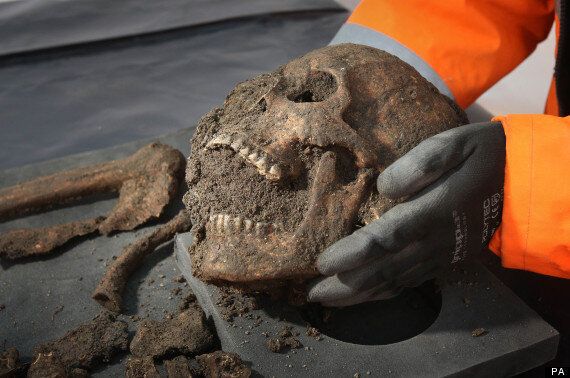The Black Death cost the lives of more than 1.5million Britons and up to 25million of our European ancestors – but new findings may be about to rewrite the story of how it was spread.
Until now it has been believed the culprit for the deadly disease was Bubonic Plague – a bacterium spread by the fleas of infected rats.
But new evidence suggests the infection was in fact airborne – Pneumonic Plague – which settles in the lungs of the victim and spreads swiftly from person to person through their infected breath.

An illustration of Italian plague victims from the XVI century
Records indicate around 60% of London’s population died during the deadly pandemic, which spread from Europe to England in 1348 – the equivalent of nearly 5million people today.
Analysis of 25 skeletons unearthed in the City of London during Europe’s Crossrail project in 2013 has yielded fresh samples of human DNA which have been subjected to new scientific tests, the findings of which will be revealed in a Channel 4 documentary next weekend.
Dr Tim Brooks, a scientist working at Public Health England in Porton Down said: “As an explanation, [rat fleas] for the Black Death in its own right, it simply isn’t good enough.

One of the skeletons found in the City of London last year
“It cannot spread fast enough from one household to the next to cause the huge number of cases that we saw during the Black Death epidemics.”
While the skeletons in question did have the deadly bacterium Yersinia pestis, which causes Bubonic Plague, researchers found the strain from 1349 is almost identical to the one present on four continents today.

The skeletons were found in on the edge of Charterhouse Square in Farringdon
The reasoning as to why the same bacterium does not spark pandemics today lies in the poor condition of the skeletons – with many showing signs of famine and disease.
Lead archaeologist Jay Carver said: “We’ve been pursing all lines of evidence, and we’re really starting to get a great picture now of the detail surrounding what we found and its historical significance, that’s allowing us to solve a 660-year-old mystery.”
Dr Barney Sloane adds: “It was the most lethal catastrophe in recorded human history. There are huge gaps in our knowledge. Historians have guessed, some of them at maybe 10 or 15% medieval chroniclers were suggesting nine out of every ten people died.”
What is astonishing is that the city didn’t crumble under the disease.
Dr Sloane said: "How do you lose 60 per cent of a city and still have that city function? You’d think the city would have collapsed under the strain of sometimes 200 bodies a day being buried.”
While the Black Death was the result of a perfect storm of circumstance, Tim Brooks of Public Health England warns it is far from a historical curiosity.
SEE ALSO:
He said: “Plague has everything it requires to cause the Black Death. All it needs is the opportunity. It’s still there. It’s still the one we used to have, it still has all the power and the threat that it used to have, and it’s only a different set of circumstances that’s keeping it in its place. Plague has what it takes. Plague can do it again.”
The findings will be featured in a new Channel 4 programme, Return Of The Black Death, which will be aired at 8pm on 6 April.